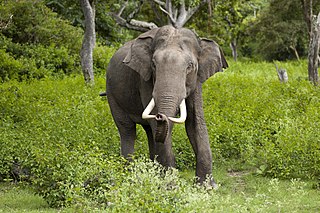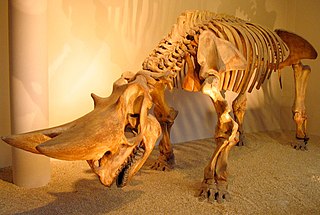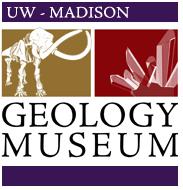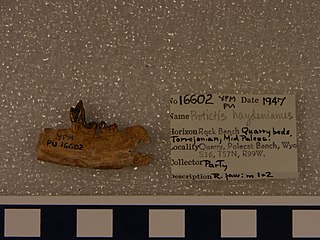
Dentition pertains to the development of teeth and their arrangement in the mouth. In particular, it is the characteristic arrangement, kind, and number of teeth in a given species at a given age. That is, the number, type, and morpho-physiology of the teeth of an animal.

Homotherium is an extinct genus of machairodontine scimitar-toothed cat that inhabited North America, South America, Eurasia, and Africa during the Pliocene and Pleistocene epochs from around 4 million to 12,000 years ago. In comparison to Smilodon, the canines of Homotherium were shorter, and it was probably adapted to running down rather than ambushing prey.

Elephantidae is a family of large, herbivorous proboscidean mammals collectively called elephants and mammoths. These are large terrestrial mammals with a snout modified into a trunk and teeth modified into tusks. Most genera and species in the family are extinct. Only two genera, Loxodonta and Elephas, are living.

The dire wolf is an extinct canine. The dire wolf lived in the Americas during the Late Pleistocene and Early Holocene epochs. The species was named in 1858, four years after the first specimen had been found. Two subspecies are recognized: Aenocyon dirus guildayi and Aenocyon dirus dirus. The largest collection of its fossils has been obtained from the Rancho La Brea Tar Pits in Los Angeles.
Articles related to the Azerbaijan Republic include:

Dimetrodon is a genus of non-mammalian synapsid that lived during the Cisuralian age of the Early Permian period, around 295–272 million years ago. It is a member of the family Sphenacodontidae. With most species measuring 1.7–4.6 m (5.6–15.1 ft) long and weighing 28–250 kg (62–551 lb), the most prominent feature of Dimetrodon is the large neural spine sail on its back formed by elongated spines extending from the vertebrae. It was an obligate quadruped and had a tall, curved skull with large teeth of different sizes set along the jaws. Most fossils have been found in the Southwestern United States, the majority of these coming from a geological deposit called the Red Beds of Texas and Oklahoma. More recently, its fossils have also been found in Germany and over a dozen species have been named since the genus was first erected in 1878.

Arsinoitherium is an extinct genus of paenungulate mammals belonging to the extinct order Embrithopoda. It is related to elephants, sirenians, and hyraxes. Arsinoitheres were superficially rhinoceros-like herbivores that lived during the Late Eocene and the Early Oligocene of North Africa from 36 to 30 million years ago, in areas of tropical rainforest and at the margin of mangrove swamps. A species described in 2004, A. giganteum, lived in Ethiopia about 27 million years ago.
Oligokyphus is an extinct genus of herbivorous tritylodontid cynodont known from the Late Triassic to Early Jurassic of Europe, Asia and North America.

The UW–Madison Geology Museum (UWGM) is a geology and paleontology museum housed in Weeks Hall, in the southwest part of the University of Wisconsin–Madison campus. The museum's main undertakings are exhibits, outreach to the public, and research. It has the second highest attendance of any museum at the University of Wisconsin–Madison, exceeded only by the Chazen Museum of Art. The museum charges no admission.

Charles Whitney Gilmore was an American paleontologist who gained renown in the early 20th century for his work on vertebrate fossils during his career at the United States National Museum. Gilmore named many dinosaurs in North America and Mongolia, including the Cretaceous sauropod Alamosaurus, Alectrosaurus, Archaeornithomimus, Bactrosaurus, Brachyceratops, Chirostenotes, Mongolosaurus, Parrosaurus, Pinacosaurus, Styracosaurus ovatus and Thescelosaurus.

Wushan Man is a set of fossilised remains of an extinct, undetermined non-hominin ape found in central China in 1985. The remains are dated to around 2 million years ago and were originally considered to represent a subspecies of Homo erectus.

Paramylodon is an extinct genus of ground sloth of the family Mylodontidae endemic to North America during the Pliocene through Pleistocene epochs, living from around ~4.9 Mya–12,000 years ago.

The Natural History Museum of Oman is a natural history museum, located at the Ministry of Heritage and Culture complex, Al Khuwair, opposite the Zawawi Mosque in Muscat, Oman.

Notiomastodon is an extinct genus of gomphothere proboscidean, endemic to South America from the Pleistocene to the beginning of the Holocene. Notiomastodon specimens reached a size similar to that of the modern Asian elephant. Like other brevirostrine gomphotheres such as Cuvieronius and Stegomastodon, Notiomastodon had a shortened lower jaw and lacked lower tusks.

A tooth is a hard, calcified structure found in the jaws of many vertebrates and used to break down food. Some animals, particularly carnivores and omnivores, also use teeth to help with capturing or wounding prey, tearing food, for defensive purposes, to intimidate other animals often including their own, or to carry prey or their young. The roots of teeth are covered by gums. Teeth are not made of bone, but rather of multiple tissues of varying density and hardness that originate from the outermost embryonic germ layer, the ectoderm.
Several mammals are known from the Mesozoic of Madagascar. The Bathonian Ambondro, known from a piece of jaw with three teeth, is the earliest known mammal with molars showing the modern, tribosphenic pattern that is characteristic of marsupial and placental mammals. Interpretations of its affinities have differed; one proposal places it in a group known as Australosphenida with other Mesozoic tribosphenic mammals from the southern continents (Gondwana) as well as the monotremes, while others favor closer affinities with northern (Laurasian) tribosphenic mammals or specifically with placentals. At least five species are known from the Maastrichtian, including a yet undescribed species known from a nearly complete skeleton that may represent a completely new group of mammals. The gondwanathere Lavanify, known from two teeth, is most closely related to other gondwanatheres found in India and Argentina. Two other teeth may represent another gondwanathere or a different kind of mammal. One molar fragment is one of the few known remains of a multituberculate mammal from Gondwana and another has been interpreted as either a marsupial or a placental.

Xenastrapotherium is an extinct genus of astrapothere, a type of hoofed herbivorous mammal, native to South America, which lived in the Middle to Late Miocene period, typically during the Laventan stage. It is a member of the family Astrapotheriidae in the subfamily Uruguaytheriinae, large astrapotheres, equipped with a trunk-like nose and protruding teeth, similar to the elephants, but their tusks were the canine teeth, not the incisors. Xenastrapotherium was a genus widely distributed in northern South America, in contrast to other species of astrapotheres which lived in the area of the Southern Cone of the continent. It differed from other astrapotheres by having two lower incisors on each side of the jaw and the tusks have a pronounced longitudinal curvature, although their general shape and size are probably very similar to Astrapotherium, whose weight would be 900 to 1,500 kilograms, comparable to the current black rhinoceros.

The Binagadi asphalt lake are a cluster of tar pits in urban Baku, Azerbaijan. Asphaltum or tar has seeped up from the ground in this area for tens of thousands of years. The tar is often covered with dust, leaves, or water. Over many centuries, animals that were trapped in the tar were preserved as bones.

Protictis is an extinct paraphyletic genus of placental mammals from extinct subfamily Didymictinae within extinct family Viverravidae, that lived in North America from early Paleocene to middle Eocene.


















